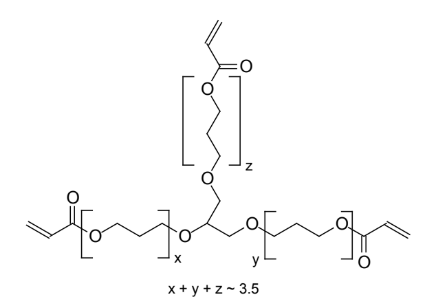Enhanced TDS
Identification & Functionality
- Blend
- No
- CASE Ingredients Functions
- Chemical Family
- Function
- Binder
- Product Code
- MITM00416
- Single Ingredient
- Yes
- Technologies
- Product Families
- Chemical Structure

Features & Benefits
- CASE Ingredients Features
- Performance Highlights
EBECRYL®53 is characterized by:
- Low viscosity
- Light color
- Very Low odor
- Excellent reduction of oligomer viscosity
- Low irritancy
- Good pigment wetting
UV/EB curable formulated products containing EBECRYL®53 are characterized by:
- Good cure response
- Good flexibility
- Excellent hardness
- Very low odor
- The actual properties of UV/EB cured products also depend on the selection of other formulation components such as oligomers, additives and photoinitiators.
Applications & Uses
- Coating End Applications
- Cure Method
- Ink & Toner End Applications
- Markets
- Applications
- Product Application
EBECRYL®53 is recommended as a diluent for UV/EB cured inks and varnishes, especially where lower odor and irritancy are desired.
Properties
- Physical Form
Packaging & Availability
- Packaging Type
Principal Information
- Group Principal Number
- S000001
- Principal
Storage & Handling
- Storage and Handling Conditions
- Care should be taken not to expose the product to high temperature conditions, direct sunlight, ignition sources, oxidizing agents, alkalis or acids.
- This might cause uncontrollable polymerization of the product with the generation of heat.
- Storage and handling should be in stainless steel, amber glass, amber polyethylene or baked phenolic lined containers.
- Procedures that remove or displace oxygen from the material should be avoided.
- Do not store this material under an oxygen free atmosphere.
- Dry air is recommended to displace material removed from the container.
- Wash thoroughly after handling.
- Keep container tightly closed.
- Use with adequate ventilation.
Other
- Appearance
- Clear liquid
- Color (SDS)
- Clear pale yellow yellowish clear liquid
- Item Number
- Odor (SDS)
- Ester like ester acrylate
- Other Hazards
- Polymerization may occur from excessive heat, contamination or exposure to direct sunlight .
- Protect from Freezing
- Yes
- Temperature Control
- Yes
- USA/DOT UN Number
- Not Applicable
- Chemical Properties
Value Units Test Method / Conditions Acid Value max. 0.4 mg KOH/g mg KOH/g - Material Composition
Value Units Test Method / Conditions Residual Solvent Content max. 10.0 ppm ppm - Optical Properties
Value Units Test Method / Conditions Color Scale max. 60.0 APHA APHA - Physical Properties
Value Units Test Method / Conditions Density 1.08 g/mL g/mL At 25°C Flash Point min. 100.0 °C °C Setaflash Melting Point max. 0.0 °C °C Moisture Content max. 0.1 % % Molecular Weight 428.0 g/mol g/mol Storage Temperature 39.2-104.0 °F °F Vapor Pressure max. 0.01 - At 20°C Viscosity 70.0-110.0 - At 25°C - SDS Physical and Chemical Properties
Value Units Test Method / Conditions Autoignition Temperature (SDS) min. 200.0 °C °C Boiling Point (SDS) min. 347.0 °C °C Density (SDS) 1.08 g/cm³ g/cm³ Flash Point (SDS) min. 208.0 °C °C Melting Point (SDS) max. -20.0 °C °C Partition coefficient n-octanol/water (SDS) 2.52 - n-octanol/water Solubility In Water (SDS) 1200.0 mg/L mg/L Vapor Pressure (SDS) max. 0.0032 - at 20°C Viscosity (SDS) 120.0-134.0 - At 20°C Volatile Content (SDS) max. 0.3 % % - Shelf Life & Stability
Value Units Test Method / Conditions Shelf Life 0.0 -
